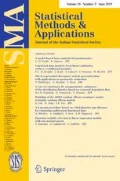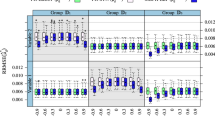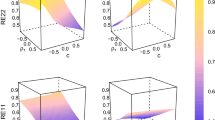Abstract
This paper introduces a temporal bivariate area-level linear mixed model with independent time effects for estimating small area socioeconomic indicators. The model is fitted by using the residual maximum likelihood method. Empirical best linear unbiased predictors of these indicators are derived. An approximation to the matrix of mean squared errors (MSE) is given and four MSE estimators are proposed. The first MSE estimator is a plug-in version of the MSE approximation. The remaining MSE estimators rely on parametric bootstrap procedures. Three simulation experiments designed to analyze the behavior of the fitting algorithm, the predictors and the MSE estimators are carried out. An application to real data from the 2005 and 2006 Spanish living conditions survey illustrate the introduced statistical methodology. The target is the estimation of 2006 poverty proportions and gaps by provinces and sex.








Similar content being viewed by others
References
Benavent R, Morales D (2016) Multivariate Fay–Herriot models for small area estimation. Comput Stat Data Anal 94:372–390
Betti G, Lemmi A (eds) (2013) Poverty and social exclusion: new methods of analysis. Routledge, London
Boubeta M, Lombardía MJ, Morales D (2016) Empirical best prediction under area-level Poisson mixed models. TEST 25:548–569
Boubeta M, Lombardía MJ, Morales D (2017) Poisson mixed models for studying the poverty in small areas. Comput Stat Data Anal 107:32–47
Burgard JP, Esteban MD, Morales D, Pérez A (2019) A Fay–Herriot model when auxiliary variables are measured with error. TEST. https://doi.org/10.1007/s11749-019-00649-3
Chandra H, Salvati N, Chambers R (2017) Small area prediction of counts under a non-stationary spatial model. Spat Stat 20:30–56
Choudry GH, Rao JNK (1989) Small area estimation using models that combine time series and cross sectional data. In: Singh AC, Whitridge P (eds) Proceedings of statistics Canada symposium on analysis of data in time, pp 67–74
Das K, Jiang J, Rao JNK (2004) Mean squared error of empirical predictor. Ann Stat 32:818–840
Datta GS, Fay RE, Ghosh M (1991) Hierarchical and empirical Bayes multivariate analysis in small area estimation. In: Proceedings of bureau of the census 1991 annual research conference. U. S. Bureau of the Census, Washington, DC, pp 63–79
Datta G, Day B, Maiti T (1998) Multivariate Bayesian small area estimation: an application to survey and satellite data. Sankhya A 60:344–362
Datta GS, Lahiri P, Maiti T, Lu KL (1999) Hierarchical Bayes estimation of unemployment rates for the U.S. states. J Am Stat Assoc 94:1074–1082
Datta GS, Lahiri P (2000) A unified measure of uncertainty of estimated best linear unbiased predictors in small area estimation problems. Stat Sin 10:613–627
Datta GS, Lahiri P, Maiti T (2002) Empirical Bayes estimation of median income of four-person families by state using time series and cross-sectional data. J Stat Plan Inference 102:83–97
Datta G, Kubokawa T, Molina I, Rao JNK (2011) Estimation of mean squared error of model-based small area estimators. TEST 20(2):367–388
Esteban MD, Morales D, Pérez A, Santamaría L (2011) Two area-level time models for estimating small area poverty indicators. J Indian Soc Agric Stat 66(11):75–89
Esteban MD, Morales D, Pérez A, Santamaría L (2012) Small area estimation of poverty proportions under area-level time models. Comput Stat Data Anal 56:2840–2855
Fabrizi E, Ferrante M, Pacei S, Trivisano C (2011) Hierarchical Bayes multivariate estimation of poverty rates based on increasing thresholds for small domains. Comput Stat Data Anal 55:1736–1747
Fay RE (1987) Application of multivariate regression of small domain estimation. In: Platek R, Rao JNK, Särndal CE, Singh MP (eds) Small area statistics. Wiley, New York, pp 91–102
Fay RE, Herriot RA (1979) Estimates of income for small places: an application of James–Stein procedures to census data. J Am Stat Assoc 74:269–277
Foster J, Greer J, Thorbecke E (1984) A class of decomposable poverty measures. Econometrica 52:761–766
Ghosh M, Nangia N, Kim D (1996) Estimation of median income of four-person families: a Bayesian time series approach. J Am Stat Assoc 91:1423–1431
Giusti C, Masserini L, Pratesi M (2017) Local comparisons of small area estimates of poverty: an application within the Tuscany region in Italy. Soc Ind Res 131(1):235–254
González-Manteiga W, Lombardía MJ, Molina I, Morales D, Santamaría L (2008) Analytic and bootstrap approximations of prediction errors under a multivariate Fay–Herriot Model. Comput Stat Data Anal 52(12):5242–5252
González-Manteiga W, Lombardía MJ, Molina I, Morales D, Santamaría L (2010) Small area estimation under Fay–Herriot models with nonparametric estimation of heteroscedasticity. Stat Model 10(2):215–239
Herrador M, Morales D, Esteban MD, Sánchez A, Santamaría L, Marhuenda Y, Pérez A (2008) Sampling design variance estimation of small area estimators in the Spanish Labour Force survey. SORT 32(2):177–198
Hobza T, Morales D (2016) Empirical best prediction under unit-level logit mixed models. J Off Stat 32(3):661–69
Hobza T, Morales D, Santamaría L (2018) Small area estimation of poverty proportions under unit-level temporal binomial-logit mixed models. TEST 27(2):270–294
Huang E, Bell W (2004) An empirical study on using ACS supplementary survey data in SAIPE state poverty models. In: 2004 Proceedings of the American statistical association. U.S. Bureau of the Census, Washington DC, pp 3677–3684
Jiang J, Nguyen T, Rao JS (2011) Best predictive small area estimation. J Am Stat Assoc 106(494):732–745
Kubokawa T (2011) On measuring uncertainty of small area estimators. J Jpn Stat Soc 41(2):93–119
Kubokawa T, Nagashima B (2011) Parametric bootstrap methods for bias correction in linear mixed models. J Multivar Anal 106:1–16
López-Vizcaíno E, Lombardía MJ, Morales D (2013) Multinomial-based small area estimation of labour force indicators. Stat Model 13:153–178
López-Vizcaíno E, Lombardía MJ, Morales D (2015) Small area estimation of labour force indicators under a multinomial model with correlated time and area effects. J R Stat Assoc Ser A 178:535–565
Marchetti S, Tzavidis N, Pratesi M (2012) Non-parametric bootstrap mean squared error estimation for M-quantile estimators of small area averages, quantiles and poverty indicators. Comput Stat Data Anal 56:2889–2902
Marchetti S, Secondi L (2017) Estimates of household consumption expenditure at provincial level in Italy by using small area estimation methods: “real” comparisons using purchasing power parities. Soc Indic Res 131(1):215–234
Marhuenda Y, Molina I, Morales D (2013) Small area estimation with spatio-temporal Fay–Herriot models. Comput Stat Data Anal 58:308–325
Molina I, Rao JNK (2010) Small area estimation of poverty indicators. Can J Stat 38:369–385
Morales D, Pagliarella MC, Salvatore R (2015) Small area estimation of poverty indicators under partitioned area-level time models. SORT—Stat Oper Res Trans 39(1):19–34
Pfeffermann D, Burck L (1990) Robust small area estimation combining time series and cross-sectional data. Surv Methodol 16:217–237
Porter AT, Wikle CK, Holan SH (2015) Small area estimation via multivariate Fay–Herriot models with latent spatial dependence. Aust N Z J Stat 57(1):15–29
Prasad NGN, Rao JNK (1990) The estimation of the mean squared error of small-area estimators. J Am Stat Assoc 85:163–171
Pratesi M (ed) (2016) Analysis of poverty data by small area estimation. Wiley, New York
Rao JNK, Yu M (1994) Small area estimation by combining time series and cross sectional data. Can J Stat 22:511–528
Särndal CE, Swensson B, Wretman J (1992) Model assisted survey sampling. Springer, New York
Singh B, Shukla G, Kundu D (2005) Spatio-temporal models in small area estimation. Surv Methodol 31:183–195
Tzavidis N, Salvati N, Pratesi M, Chambers R (2008) M-quantile models with application to poverty mapping. Stat Methods Appl 17:393–411
Tzavidis N, Ranalli MG, Salvati N, Dreassi E, Chambers R (2015) Robust small area prediction for counts. Stat Methods Med Res 24:373–395
You Y, Rao JNK (2000) Hierarchical Bayes estimation of small area means using multi-level models. Surv Methodol 26:173–181
Author information
Authors and Affiliations
Corresponding author
Additional information
Publisher's Note
Springer Nature remains neutral with regard to jurisdictional claims in published maps and institutional affiliations.
Supported by the Spanish Grant PGC2018-096840-B-I00 from Ministerio de Ciencia, Innovación y Universidades.
Rights and permissions
About this article
Cite this article
Benavent, R., Morales, D. Small area estimation under a temporal bivariate area-level linear mixed model with independent time effects. Stat Methods Appl 30, 195–222 (2021). https://doi.org/10.1007/s10260-020-00521-x
Accepted:
Published:
Issue Date:
DOI: https://doi.org/10.1007/s10260-020-00521-x
Keywords
- Area-level linear mixed models
- Multivariate models
- Temporal models
- Small area estimation
- Poverty mapping




